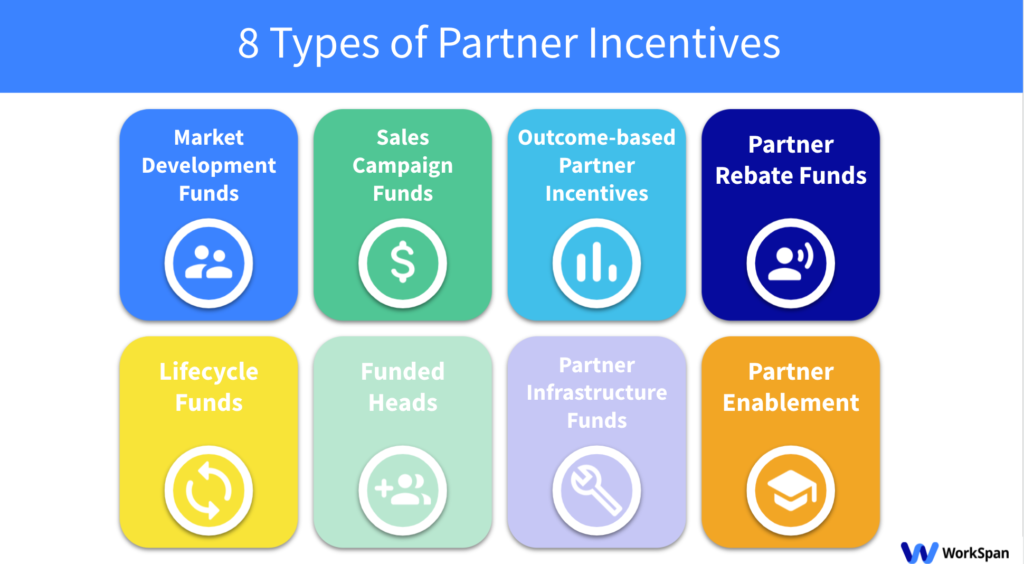
With the rapid move to cloud and digital transformation, businesses are evolving and looking for new ways to boost their channel sales. The old ways of channel management have dramatically changed. Ecosystem partners can no longer be categorized in traditional roles, instead, they work together to drive value across the full customer journey. As partner types are blurring, and focus is on delivering customer value to ensure renewals, driving the right partner behavior, and ensuring alignment within the ecosystem is more important than ever. So how do you stay aligned with your ecosystem partners and motivate them to take actions you want them to take at the right time? You reward them with partner incentives!
Partner incentives are the rewards your company gives to help steer partners in the right direction to drive value motions, boost market penetration and amplify product demand. Ensuring that you implement the right partner incentives is therefore crucial to the success of your partner co-selling. We explained the eight types of partner incentives in our brand new Ultimate MDF and Partner Funds Guide. In this blog, we’ll be diving deeper into each of these types of partner funds and explain how your company can best utilize them to drive your channel sales!

Figure 1: 8 Types of Partner Incentives
1. Market Development Funds
The granddaddy of partner incentives, Market Development Funds, or MDFs are investments that are used to drive awareness and demand for your solutions. More simply put, these are funds that your company sets aside to be used for go-to-market and partner marketing activities for your collaborative offering. Examples of effective uses for these partner funds include digital marketing and in-person marketing like conferences, trade shows, webinars, email campaigns, local advertising (billboards, yellow pages, newspapers), and more. MDF can also cover sales activities like proof-of-concept and other sales programs. Because of the versatility that these partner funds can offer to your partners, building an effective MDF program is imperative for driving your channel sales.
Featured Free Resource:

To learn in depth about driving partner incentives and market development funds, get your free copy of The Ultimate MDF and Partner Funds Guide. Download now, read later!
In order to drive more channel sales, companies pay MDFs for their partners. An example of these kinds of partner incentives is the VMware/Intel Amplify Program. Under this unique program, partners are given incentives to deploy VMware software on Intel-based servers. The really interesting part of this program is that partners get dual funding (from VMware and Intel) and both companies release the funds directly to partners - without delaying the process. Such joint programs to drive MDFs are growing as companies are able to pool resources with low cost per activity.
Recommended Watch: [On-Demand Webinar] 5 Ways to Boost your MDF Program with WorkSpan
2. Sales Campaign Funds
As we outlined earlier, the purpose of partner incentives is to help you with channel management and motivate partners into taking the right actions to drive value for your customer. With Sales Campaign Funds, your company incentivizes partners to execute a sales campaign that your company has created. Because actions in the sales campaign can be strategically planned by your company, these partner funds allow you to directly orchestrate the right actions for your ecosystem to boost channel sales within a set period.
3. Outcome-Based Partner Incentives
Similar to the Sales Campaign Funds, Outcome-Based Partner Incentives allow your company to define exactly which actions you want your partners to take. More specifically, these are set payouts that are given to partners for executing recommended activities and pre-defined payouts. These partner funds are usually already baked into the rewards your partner receives based on sales earnings but strategically using these incentives on a discretionary basis is also important for keeping partners engaged and driving channel sales.
A good example of an organization that is driving outcome-based partner incentives for its partners is VMware. VMware has devised a series of partner incentive programs to accelerate sales by offering outcome-based partner incentives for POCs, Tech Assessments, and P2P partner engagement that incentivizes partners to use more of their solutions.
4. Partner Rebate Funds
Partner Rebate Funds are volume discounts that your company gives to channel partners that increase their profitability thus incentivizing them to drive channel sales. These rebates are given as a percentage of sales driven by your partners and are allocated after hitting a predetermined target within a specified period. Commonly these targets are revenue-related however, as subscription-based models are increasing, your company may decide to create targets surrounding customers to reward a more specific behavior. Alternatively, if your company wants to sell to a larger group of customers, making targets related to new market penetration would also be an effective way to structure these partner funds. When strategizing partner rebate funds for your partners, make sure your rebate strategy is perfectly aligned with your and your partner’s business needs.
Partner Rebate Funds are much like the rebates that car sales offices use to incent a purchase of a car (with financing rates) with car dealers. Similarly, in tech, rebates are normally used for volume incentives, meaning that your partner has to sell a specific amount of your offerings to receive a partner rebate.
5. Lifecycle Funds
Customers don’t want to buy single products and narrow solutions anymore. Now, they expect fully integrated, end-to-end, tailor-made joint solutions that create a holistic customer experience. With Lifecycle Funds, your company can incentivize partners to create this holistic customer experience. In this category of partner incentives, your partners are engaged across the whole lifecycle of your customers, from pre-sales activities to post-sales activities like adoption, enablement, consumption, and renewal. Helping customers understand your product’s value is an example of a behavior that may be rewarded through these lifecycle funds.
With so many business models driven by subscription-based pricing with annual renewals, Lifecycle Funds are a critical tool to align your partners to your customer renewal strategy. For example, Cisco is using customer lifecycle fund programs to drive value across the full customer lifecycle. The company focuses on a lifecycle-first approach on its Lifecycle incentive partner programs where ecosystem partners are rewarded across the lifecycle.
6. Funded Heads
In this type of funding, you fund the cost of an employee or an entire team that “lives” inside your partner’s organization. These employees are fully dedicated to supporting your company’s product inside your partner’s organization and are known as “funded heads.” These dedicated employees are embedded within your partner organization to drive partner marketing, sales engineering, sales support, and other activities to help grow your channel sales with that partner, making sure your partner represents your product in the best possible way.
For example, Intel provides headcount funds to have dedicated people located in their partner offices managing Intel’s MDF programs.
7. Partner Infrastructure Funds
Partners are often engaged in activities that may require substantial investments of infrastructure in order to support shared go-to-market activities. Examples are abundant with hardware providers where companies fund network equipment, servers, end-point demonstration equipment, and so on inside their partner’s Executive Briefing Center for their shared customers to have a full experience in context with their shared solutions. These kinds of partner incentives to support partners' infrastructure costs are called partner infrastructure funds. With software partners, infrastructure funds could be paid to provide ongoing cloud services for demonstration, POCs, and other sales-support activities.
8. Partner Enablement
For an effective ecosystem and channel management, ensuring your partners have a depth of knowledge surrounding your product is a must. Your partners’ ability to sell your collaborative offerings is a huge factor in your channel sales and ecosystem success as a whole. Look to Partner enablement funds as a way to enable your ecosystem partners to reach new customers and represent your business in the best way possible. These partner funds are used specifically to fund partner training and certifications. For example, you could utilize these partner incentives by funding a certification program to ensure that your partners understand your product’s target market.
The Bottom Line
We hope you got an idea about the 8 types of partner incentives to drive your channel sales. Regardless of which partner funds you choose to employ, efficient fund management processes, robust reporting, strong audit & compliance support, good integration with your financial systems & collaboration at scale are all necessary so that you can engage and enable all your ecosystem partners. For best practices on how to best utilize these partner funds, how to create your own Market Development Fund Program and how automation technology can simplify these processes, check out our brand new Ultimate MDF and Partner Funds Guide.
[hubspot type=form portal=4417116 id=3047ae32-6020-42fa-8309-bb3693e9f444]
Heading
Heading 1
Heading 2
Heading 3
Heading 4
Heading 5
Heading 6
Lorem ipsum dolor sit amet, consectetur adipiscing elit, sed do eiusmod tempor incididunt ut labore et dolore magna aliqua. Ut enim ad minim veniam, quis nostrud exercitation ullamco laboris nisi ut aliquip ex ea commodo consequat. Duis aute irure dolor in reprehenderit in voluptate velit esse cillum dolore eu fugiat nulla pariatur.
Block quote
Ordered list
- Item 1
- Item 2
- Item 3
Unordered list
- Item A
- Item B
- Item C
Bold text
Emphasis
Superscript
Subscript





.png)